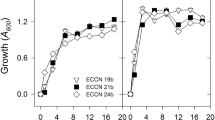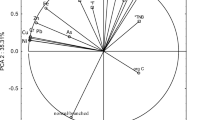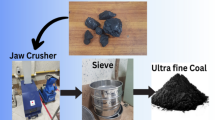Abstract
Previous studies have made some progress with the use of microbial community properties as assessment criteria for rehabilitation success of post-mining areas. Currently, there is a need for reference ranges of specific properties in rehabilitated post-mining sites to make this approach more practical. The aim of this investigation was to compare assessment parameters indicative of microbial community function (enzymatic assays) and structure (phospholipid fatty acid (PLFA) analysis) in rehabilitated asbestos and coal discard sites and to establish ranges of minimum and maximum values for these parameters in both types of sites. The range established for dehydrogenase activity in coal discard sites was 24.3–339.5 μg INF g−1 2 h−1 and for asbestos 44.5–544.6 μg INF g−1 2 h−1. Ranges were also established for β-glucosidase, urease, acid phosphatase and alkaline phosphatase. Complete PLFA profiles were determined and ranges established for major PLFA groups and ratios in both types of discard. From the PLFA profiles, viable microbial biomass was determined as 6,080–29,851 and 8,128–47,242 pmol g−1 dry weight for the coal and asbestos discard sites, respectively. While similar ranges were observed for both types of discard, a canonical correspondence analysis that accounts for functional and structural characteristics showed that sites clustered according to the origin of the samples.


Similar content being viewed by others
References
Alef, K., & Nannipieri, P. (1995). Methods in applied soil microbiology and biochemistry. Boston: Academic. 576p.
Allison, V. J., Miller, R. M., Jastrow, J. D., Matamala, R., & Zak, D. R. (2005). Changes in soil microbial community structure in a tallgrass prairie chronosequence. Soil Science Society of America Journal, 69, 1412–1421.
ASTM (American Society for Testing and Materials). (1961). Tentative method for grain-size analysis of soils. In The 1961 book of ASTM standards. Philadelphia: ASTM.
Badiane, N. N. Y., Chotte, J. L., Pate, E., Masse, D., & Rouland, C. (2001). Use of soil enzyme activities to monitor soil quality in natural and improved fallows in semi-arid tropical regions. Applied Soil Ecology, 18, 229–238.
Bandick, A. K., & Dick, R. P. (1999). Field management effects on soil enzyme activities. Soil Biology and Biochemistry, 31, 1471–1479.
Banwart, W. L., Bremner, J. M., & Tabatabai, M. A. (1972). Determination of ammonium in soil extracts and water samples by an ammonia electrode. Communications in Soil Science and Plant Analysis, 3, 449.
Bardgett, R. D., & McAlister, E. (1999). The measurement of soil fungal:bacterial biomass ratios as an indicator of ecosystem self-regulation in temperate meadow grasslands. Biology and Fertility of Soils, 29, 282–290.
Bartelt-Ryser, J., Joshi, J., Schmid, B., Brandl, H., & Balser, T. (2005). Soil feedbacks of plant diversity on soil microbial communities and subsequent plant growth. Perspectives in Plant Ecology, Evolution and Systematics, 7, 27–49.
Bray, R. H., & Kurtz, L. T. (1945). Determination of total, organic and available forms of phosphorus in soils. Soil Science, 59, 39–45.
Bredenkamp, G., Granger, J. E., & van Rooyen, N. (1996). Savannah Biome. In A. B. Low & A. G. Robelo (Eds.), Vegetation of South Africa, Lesotho and Swaziland. Pretoria: Department of Environmental Affairs and Tourism.
Claassens, S., Riedel, K. J., Van Rensburg, L., Bezuidenhout, J. J., & Jansen van Rensburg, P. J. (2006). Microbial community function and structure on coal mine discard under rehabilitation. South African Journal of Plant and Soil, 23, 105–112.
Claassens, S., Jansen van Rensburg, P. J., Maboeta, M. S., & van Rensburg, L. (2008). Soil microbial community function and structure in a post-mining chronosequence. Water, Air, and Soil Pollution, 194, 315–329.
Dick, R. P., Breakwell, D. P., & Turco, R. F. (1996). Soil enzyme activities and biodiversity measurements as integrative microbiological indicators. In J. W. Doran & A. J. Jones (Eds.), Methods for assessing soil quality, SSSA special publication 49 (pp. 247–271). Madison: SSSA.
Dick, W. A., Cheng, L., & Wang, P. (2000). Soil acid and alkaline phosphatase activity as pH adjustment indicators. Soil Biology and Biochemistry, 32, 1915–1919.
Federle, T. W. (1986). Microbial distribution in soil—new techniques. In F. Megusar & M. Gantar (Eds.), Perspectives in microbial ecology (pp. 493–498). Ljubljana: Slovene Society of Microbiology.
Fierer, N., Schimel, J. P., & Holden, P. A. (2003). Variations in microbial community composition through two soil depth profiles. Soil Biology and Biochemistry, 35, 167–176.
Frostegård, A., & Bååth, E. (1996). The use of phospholipid fatty acid analysis to estimate bacterial and fungal biomass in soil. Biology and Fertility of Soils, 22, 59–65.
Guckert, J. B., Antworth, C. P., Nichols, P. D., & White, D. C. (1985). Phospholipid, ester-linked fatty acid profiles as reproducible assays for changes in prokaryotic community structure of estuarine sediments. FEMS Microbiology Ecology, 31, 147–158.
Harris, J. A., & Birch, P. (1989). Soil microbial activity in opencast coal mine restorations. Soil Use and Management, 5, 155–160.
Ibekwe, A. M., Kennedy, A. C., Frohne, P. S., Papiernik, S. K., Yang, C. H., & Crowley, D. E. (2002). Microbial diversity along a transect of agronomic zones. FEMS Microbiology Ecology, 39, 183–191.
Kieft, T. L., Ringelberg, D. B., & White, D. C. (1994). Changes in ester-linked phospholipid fatty acid profiles of subsurface bacteria during starvation and dessication in a porous medium. Applied and Environmental Microbiology, 60, 3292–3299.
Liebenberg-Weyers, D. (2010). A multidisciplinary approach for the assessment of rehabilitation at asbestos mines in South Africa. Dissertation—M.Sc. Environmental Science, North-West University, Potchefstroom Campus, Potchefstroom, South Africa, 131p.
McKinley, V. L., Peacock, A. D., & White, D. C. (2005). Microbial community PLFA and PHB responses to ecosystem restoration in tallgrass prairie soils. Soil Biology and Biochemistry, 37, 1946–1958.
Milton, S. J. (2001). Rethinking ecological rehabilitation in arid and winter rainfall regions of southern Africa. South African Journal of Science, 97, 1–2.
Morgenthal, T. L., & Van Rensburg, L. (2004). Ecosystem development on seven rehabilitated discard dumps. African Journal of Range and Forage Science, 21, 57–67.
Ndiaye, E. L., Sandero, J. M., McGrath, D., & Dick, R. P. (2000). Integrative biological indicators for detecting changes in soil quality. American Journal of Alternative Agriculture, 15, 26–36.
Olsson, P. A. (1999). Signature fatty acids provide tools for determination of the distribution and interactions of mycorrhizal fungi in soil. FEMS Microbiology Ecology, 29, 303–310.
Peacock, A. D., Mullen, M. D., Ringelberg, D. B., Tyler, D. D., Hedrick, D. B., Gale, P. M., et al. (2001). Soil microbial community responses to dairy manure or ammonium nitrate applications. Soil Biology and Biochemistry, 33, 1011–1019.
Peacock, A. D., Macnaughton, S. J., Cantu, J. M., Dale, V. H., & White, D. C. (2002). Soil microbial biomass and community composition along an anthropogenic disturbance gradient within a long-leaf pine habitat. Ecological Indicators, 12, 1–9.
Peech, M. (1965). Hydrogen-ion activity. In C. A. Black (Ed.), Methods of soil analysis, Part 2. Agronomy monographs 9 (pp. 914–926). Madison: ASA.
Ponder, F., & Tadros, M. (2002). Phospholipid fatty acids in forest soil four years after organic matter removal and soil compaction. Applied Soil Ecology, 19, 173–182.
Ramiriz-Munoz, J. (1968). Atomic absorption spectroscopy and analysis by atomic absorption flame photometry. New York: Elsevier.
Sicardi, M., García-Préchac, F., & Frioni, L. (2004). Soil microbial indicators sensitive to land use conversion from pastures to commercial Eucalyptus grandis (Hill ex Maiden) plantations in Uruguay. Applied Soil Ecology, 27, 125–133.
Simard, R. R. (1993). Ammonium acetate—extractable elements. In M. R. Carter (Ed.), Soil sampling and methods of analysis (pp. 39–42). USA: CRC.
Smith, C. A., Phiefer, C. B., Macnaughton, S. J., Peacock, A., Burkhalter, R. S., Kirkegaard, R., et al. (2000). Quantitative lipid biomarker detection of unculturable microbes and chlorine exposure in water distribution system biofilms. Water Research, 34, 2683–2688.
Ter Braak, C. F., & Šmilauer, P. (1998). Canoco reference manual for user’s guide to Canoco community ordination, ver. 4. New York: Microcomputer Power.
Walkley, A., & Black, I. A. (1934). An examination of the Degiareff method for determining SOM and a proposed modification of the chromic acid titration method. Soil Science, 37, 29–38.
White, D. C., Stair, J. O., & Ringelberg, D. B. (1996). Quantitative comparisons of in situ microbial biodiversity by signature biomarker analysis. Journal of Industrial Microbiology, 17, 185–196.
Acknowledgements
The authors would like to thank the mining companies involved in this project for access to the rehabilitated sites. This research was performed with the financial support of the National Research Foundation, South Africa.
Author information
Authors and Affiliations
Corresponding author
Rights and permissions
About this article
Cite this article
Claassens, S., Jansen van Rensburg, P., Liebenberg, D. et al. A Comparison of Microbial Community Function and Structure in Rehabilitated Asbestos and Coal Discard Sites. Water Air Soil Pollut 223, 1091–1100 (2012). https://doi.org/10.1007/s11270-011-0927-1
Received:
Accepted:
Published:
Issue Date:
DOI: https://doi.org/10.1007/s11270-011-0927-1




